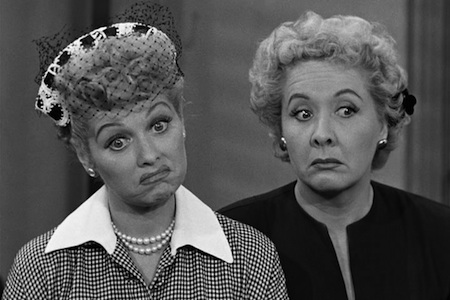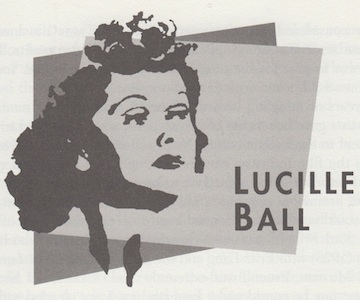Born: August 6, 1911, Celeron, NY
Died: April 26, 1989, Los Angeles, CA
I didn’t take well to movies and they didn’t take well to me.
—Lucille Ball
As a product of several New York drama schools, Lucille Ball became extremely frustrated when her stage career turned out to be a series of misses, so in late 1929, Lucy decided to take a shot at Hollywood. She ended up as a walk-on Goldwyn girl in a Busby Berkeley chorus line for Roman Scandals (1933), won substantial praise for her work in another film, Stage Door (1937) and shortly thereafter signed with MGM to appear in more films. Unfortunately, her assignments were always as a bit player in B productions. In preparation for The Big Street (1942), Lucy went to see Max Factor for a makeover and left with a new look. Her hair took on a striking red hue that she would keep for the rest of her life.
In 1947, she teamed with husband Desi Arnaz for a live vaudeville-style tour and did some radio work for CBS that met with audience approval. The situation comedy of a wacky housewife and her husband adapted easily to the growing medium of television, and Lucy and Desi Arnaz started I Love Lucy in 1951.
“Wasn’t that girl just a bit player at RKO a few weeks ago?” movie stars would chuckle among themselves. Surely Lucy would destroy her chances of ever making it big in films, they speculated. After all, it was well known around Hollywood studios that the executives in charge frowned upon an actor who considered television parts. Television was the lowly, artless medium, and its stay-at-home appeal was hurting picture profits. To work in television was to play for the other team. You were a traitor. You were an outcast. You would never work in movies again.
Lucy’s years of mingling with the dancers, singers, crew members and makeup artists gave her plenty of connections, which she used to lure Hollywood talent to the lowly medium. Nearly all of her original TV technicians were from the film industry: cameramen, lighting and sound specialists, even Max Factor’s son, had signed on to keep Lucy radiant.
The most prominent acquisition was director Karl Freund. Desi Arnaz felt the show would need an experienced hand to preserve the look of the series over time. Karl Freund was an Oscar-winning cameraman who had filmed Metropolis (1927) with Fritz Lang and the acclaimed The Last Laugh (1924) with F.W. Murnau. Freund was extremely fond of Lucy, but he hated the idea of television; he considered it beneath him. Lucy pleaded with him and assured him he would have the best working conditions and the proper support. He could hand-select his staff. In addition, Lucy offered him a handsome and regular paycheck. Freund took the deal, stunning his colleagues, and suddenly Hollywood was paying attention.
Arnaz and Freund’s first decision was how to record the episodes. They chose film instead of video, and their prophetic wisdom would lead to significant profits from reruns (It was later discovered that the archives of many of the early classic TV programs that used videotape had been erased or ruined, destroying all chances of syndication profit). Next, Freund opted for a revolutionary three-camera technique for filming live television shows. The pioneering method was picked up by director Alfred Hitchcock, who adapted the process and used it extensively.
I Love Lucy had rippling effects in Hollywood. The instant popularity of the TV series made Lucy an overnight sensation. In just six months, more than ten million people were watching her series, and it retained the number one position until 1957. Her fame startled the film industry.
Eventually, Lucy’s success was also instrumental in mending the relationship between the film and television industries. Her show was the first to give studios an opportunity to pitch their upcoming movies through cameo TV appearances. Stars who knew Lucy from the studios—some of them among the biggest stars in Hollywood—might have vowed never to work in television, but broke down and made their first appearances with the outrageous redhead, usually at union scale. William Holden, John Wayne, Bob Hope, Rock Hudson, Richard Widmark and Orson Welles all stopped in at the Ricardo residence and made television history.
Lucy’s return to theatrical features was heralded as the prodigal coming home. Her subsequent film work in The Long, Long Trailer (1954) and Yours, Mine and Ours (1968) demonstrated television’s ability to create bankable stars for future full-length features. By the time Delbert Mann’s presentation of Marty, originally shown live on the Philco Playhouse, had transcended the small screen to win four Oscars, including Best Picture of 1955, the lines were blurred. Many Hollywood directors and screenwriters were convinced that work on television could only help their careers. In fact, television would soon produce the next generation of stars on both sides of the movie camera.
In 1962, after lengthy divorce proceedings, Lucy assumed control of RKO, the same studio where she had struggled to become a movie star. She was the first female studio head in Hollywood since Mary Pickford had a stake in United Artists; she headed production of more than fifty TV series, including Mission Impossible and Star Trek, and in 1967 she sold the studio for a $10 million profit. Lucille Ball had become the first film actress to make the transition from movies to television and back again to movies successfully. Her trailblazing success forever connected the two industries.
To read all the republished articles from ‘The Film 100,’ as well as the complete list of 100 most influential people in the history of the movies, go to Reintroducing the Film 100 here on Keyframe.





